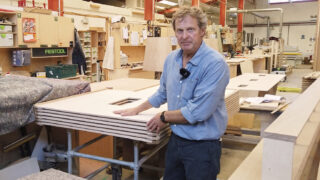Sean Sutcliffe
Interview : 1

Why are you involved in this project?
Sean Sutcliffe [SS]: It is pertinent at this moment to explore new ways of working remotely – and of creating at a distance. It’s by no means the first time we’ve developed furniture using digital communication tools, but this will be the first time we’ve developed pieces in a purely digital environment, without visits to our workshops from designers. I’m interested to see what the lockdown period has made designers think about in terms of product development. How does working from home influence the furniture in our home, and its functional requirements?
How do you see work changing, especially in what Benchmark does? Could virtual design and making be a thing that stays?
SS: Virtual working is certainly here to stay. All our collective experiences of working via Zoom have changed the design development process. People will still want to visit our workshops for design meetings – the physical and the tactile experience will remain a key component of the creative process when working with natural materials. But I expect a small number will visit in person, with a greater proportion joining digitally.
I also expect to see a new focus on the anti-microbial properties of surfaces and the physical separation of space via screening that we haven’t known in our lifetime.
Through our work with the Cleveland Clinic in the USA, we have explored the anti-microbial and the infection control properties of wood. For years, our focus on human health and well-being has informed our decisions around product development. I hope these considerations will increasingly sit at the forefront of people’s minds, both for workplace furniture and furniture for the home.
How are the craftsmen feeling about working in this way?
SS: The craftspeople in our workshop are used to using phones and iPads to review designs. But to do it entirely via this medium will raise questions as to whether digital communication can convey the subtleties of good craftsmanship. Proportion looks different through the naked eye than it does through a lens and the sense of scale is important in person.
The tactile quality and fine detailing – particularly where surfaces meet, is something that all us craftspeople use our hands as well as our eyes to evaluate. While the camera can do some of the work of the eyes, it can’t do the work of the hands. As such, I expect there will be a level of scepticism as to whether digital can communicate the quality of a piece of handmade furniture.